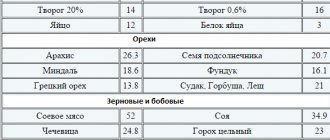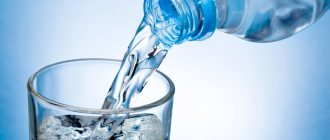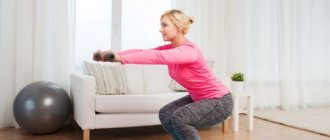What you absolutely can’t do AFTER training: you can’t do the whole 9 – Om Activ
- Be strong
- Low fat
- THINK & DRINK
- NO STRESS
- More fun
- Om kids
The first two reasons are already enough to make you want to deadlift every day.
Broccoli and its sprouts are the richest source of sulforaphane, a powerful anti-cancer substance. We tell you what you need to do with broccoli to activate it.
No, there is more than one word in the article. They gave a detailed answer.
During pregnancy, only one method of hair removal is strictly prohibited. But each procedure has subtleties - we told you about everything.
Live photos and real emotions.
During pregnancy, only one method of hair removal is strictly prohibited. But each procedure has subtleties - we told you about everything.
- Be strong
- Low fat
- THINK & DRINK
- NO STRESS
- More fun
- Om kids
What you absolutely can’t do AFTER training: you can’t do the whole 9
What you absolutely can’t do AFTER training: you can’t do the whole 9
fitness instructor, exercise therapy specialist, senior trainer at ZSport
#1 Complete cardio workout
After a strength workout, many people rush to the cardio zone for 40 minutes to an hour in order to get rid of even more calories once they come to the gym. But it's not that simple. After an hour-long workout, stress and destruction hormones, including cortisol, are at their peak. With such a hormonal background, muscles break down faster than fat tissue. So you won't be dry and lean, but thin with excess fat on your sides. Moreover, this is an excessive load on the heart.
What to do: Light cardio cool-down for 10-20 minutes. It will normalize the cardiovascular system, restore strength and return the body to normal mode.
#2 Full stretching after strength training
If your goal is to increase muscle strength, then this concerns you more than others. Full stretching lasts at least an hour, and recovery processes begin immediately after an hour-long workout and last about two hours. That is, you do stretching in this way at a time when the body should already be resting.
After strength training, the muscles need to adapt to the load received - only then do they become stronger. Due to stretching, this effect is smeared.
Plus, after strength training you need to have a snack - because of stretching, you will miss this important meal.
What to do:
- 1
after strength training – recover on the treadmill, - 2
after functional or other non-strength training - light stretch for 20-25 minutes. It will increase the amplitude of joints, lengthen muscles and help recovery, - 3
For complete stretching, set aside a separate day.
#3 Massage
Massage, like stretching, is a good restorative process. But you shouldn’t run to a massage therapist immediately after training - let your muscles spend a few hours in their own recovery mode.
What to do: Get a massage at least the next day after your workout. When you experience pain from inflammatory processes in the muscles, massage will be much more beneficial! It will increase blood circulation in the muscles, deliver useful components to them, and also accelerate the elimination of products remaining after recovery processes.
#4 Overeat
After exercise, we often experience a voracious appetite and the feeling that we need a lot of food to restore muscles. But if we take complex foods, including fats, proteins, and slow carbohydrates, all the energy goes into the digestion process and creates a calorie deficit. Also, cortisol, the level of which is high after exercise, blocks protein absorption. There is no point in taking protein in huge quantities - most of it will be excreted in the urine.
What to do: Take sports nutrition 20 minutes after training.
Protein-carbohydrate and vitamin cocktails, BCAA supplements and bars with fast carbohydrates will help you. They will provide a large portion of useful substances, providing the muscles with the necessary elements for recovery, and the body will not spend a large amount of energy on digestion. 1.5-2 hours after training and taking sports nutrition, you can have a full meal.
How to properly resume training after a cold?
Doctors do not advise returning to training immediately after the end of the illness. It is recommended to wait at least two or three days and only then start exercising again. This allows you to eliminate the risk of a relapse of the cold and fully recover. In the first days after the illness, continue to consume large amounts of warm liquid and vitamins. Proper nutrition plays a vital role in maintaining and restoring the body.
Experienced athletes never start training as usual immediately after a cold. Light exercises with low intensity are performed first. The loads are increased gradually, that is, from lesson to lesson. If you ignore this transition period, starting to train according to the same program as before the illness, the likelihood of exhaustion of the body and a relapse of the cold increases.
The first few workouts can be done at home, rather than in the gym. It's enough to just exercise with your own weight. This will remind the body, which was resting, of the need for physical development, and will allow it to prepare for more complex training.
Reasons for prohibiting loads
Botox, Dysport, Xeomin are medical products derived from botulinum toxin and are usually used to reduce the activity of individual muscles. They have proven their effectiveness, but they must be used very carefully. It is necessary to carefully prepare for injections and strictly follow the recommendations of a specialist during the rehabilitation period.
Sports after Botox are prohibited, as are other stresses on the body. Let's try to understand the reasons for this ban.
Loss of result
Is it possible to immediately play sports after Botox injections? If you are a pro in this field, we recommend weighing all the pros and cons, because the procedure eliminates any stress. And downtime of 3-4 days can negate the results you have achieved.
There is one more point. The effect of botulinum toxin, on the basis of which Botox is produced, may not appear at all if you resume training in the gym immediately after the injections.
When you work out in the gym, all your muscles are used, even if you don't feel it. For example, when jumping, running, or strength training, the muscles shake. This can lead to the spread of the active substance beyond the treated area.
Also, during exercise, the work of the heart increases, blood circulation accelerates, body temperature rises, and metabolism becomes more active. Thus, the drug is eliminated ahead of schedule. Accordingly, the result does not appear or is completely absent.
Side effects
Botox is considered safe. The risk of complications with injections is quite low. In addition, most of them are moderate and temporary. But this is only provided that the procedure is performed by an experienced cosmetologist and all rehabilitation rules have been followed.
If you engage in sports immediately after botulinum toxin injection, this may lead to the following undesirable reactions of the body:
- Pain, swelling, bruising at the injection site.
- Headache, flu symptoms.
- Crooked smile, drooling.
- Dry mouth.
- Pain in the neck.
Botox and other injectable drugs are made from the same substance that causes botulism. Therefore, in rare cases, active training after the procedure can lead to symptoms of this disease:
- Muscle weakness throughout the body.
- Vision problems.
- Difficulty talking or swallowing.
- Loss of urinary control.
To avoid such reactions, check with your cosmetologist about how long you can’t exercise after Botox for the eyes, eyebrows, and forehead.
Neglect the choice of sportswear and shoes
Sportswear isn't that same old synthetic T-shirt you don't mind, and certainly not the shorts you wore last year. Suits for training, like shoes, must be purchased in a special store and match your size, season and conditions in which you train (at home, on the street, in the gym, etc.). In addition, they should be light and not impede movement. Experts do not recommend buying cotton sportswear: it quickly absorbs sweat, sticks to the body and prevents the skin from breathing. It is better if your suit is made from a material that combines cotton, lycra, polyester, elastane, and nylon. Such sportswear does not stretch, holds its shape well and is pleasant to the body.
When can you resume training?
Typically, load restrictions apply only to the rehabilitation period. But in some cases, the doctor may ask the patient to stop exercising 2-3 days before the injection session.
This recommendation is due to the fact that due to constant tension, the muscles become tight. This prevents the botulinum toxin from being distributed evenly in the treated area. After injections, the duration of abstinence from training is determined individually.
Time
During the first 2 hours after Botox injections, the patient should not lie down or expose himself to significant physical activity. There is also no need to lower your head. Botulinum toxin can enter peripheral muscles and cause unwanted and unexpected effects.
You cannot massage for 6 hours. It is also recommended to avoid strong muscle contractions in the treated areas.
You can return to professional activities immediately, but precautions should be taken. Sports activity, according to doctors, can be resumed after 24 hours. This time is enough for the botulinum toxin to stabilize at the injection sites.
Exercises
Female athletes who resort to salon “beauty injections” most often do:
- roller skating;
- running;
- fitness;
- training at home;
- yoga and pilates;
- dancing;
- water aerobics.
After Botox injections, all of the listed activities are prohibited for 14 days. You should not bend or squat at home, even when performing daily household duties.
It is permissible to start classes only 3 weeks after the injections. The first workouts should contain no more than 2-4 lightweight exercises. They should be performed throughout the day. You can do breathing exercises, stretching, leg swings and torso twists.
They must be performed exclusively in two positions - sitting or standing. Under no circumstances should you lie down.
Then you can add more complex exercises to this light version of the workout. Including from a lying position. Squatting and bending are allowed. Swimming, dancing and fitness classes can be resumed 15-20 days after botulinum toxin injections.
Serious cardio and strength training can be planned no earlier than a month after the anti-aging injections. But keep in mind that such activity will contribute to the accelerated removal of Botox.
Is it possible to walk if you have a cold?
Walking and exercising in the fresh air as preventive measures is one thing, but trying to harden yourself at a time when the disease has already overtaken you is completely different.
Ideally, you should wait until the condition improves. In the meantime, you feel sick, you just need to open the window at home as often as possible. If it is cold outside, for those 15 minutes while the window is slightly open, the sick person should retire to another room.
Walking when you have a cold is allowed under the following conditions:
- body temperature is normal;
- no weakness, nausea;
- no severe cough;
- there is no wind, rain, or frost outside.
At the same time, reduce the load as much as possible: do not run, do not walk quickly, reduce the walking time to 20-30 minutes. If you are diagnosed with influenza or a sore throat, and not a simple acute respiratory viral infection, postpone walking until you have fully recovered. Reason: the body is very weakened, and if you get even a little cold or wet, your immune forces will not be able to cope with the virus or bacteria, and the already subsiding disease may return.
A healthy mind lives in a healthy body, says the Russian proverb. Let us agree with popular wisdom: only by feeling healthy and physically strong can you enjoy all the benefits of life and provide help to those who need it. But when you start exercising, listen to the signals that your body sends you: if it requires rest, you need to give it this opportunity. Only then will physical education and sports be beneficial!
Restrictions
Botulinum toxin is a strong poison. In small dosages it is not dangerous to humans. But if the recommendations are not followed during preparation for the procedure and rehabilitation, it can lead to side effects and complications. Therefore, the list of restrictions is quite extensive.
In addition to sports, after Botox injections it is prohibited:
- take horizontal poses for 4-5 hours;
- bend over (the time frame is similar to the first prohibition);
- massage injection sites;
- expose the body to any physical activity for at least 2-3 days;
- visit a bathhouse, sauna, and also take a hot bath for 24 hours;
- use aggressive cosmetic products (peeling, scrub);
- apply decorative cosmetics (eyeshadow, tone, blush);
- drink alcohol for 10-14 days;
- eat salty or spicy foods;
- use the services of dentists if injections were given in the area of the nasolabial folds.
If the above requirements are met, the risk of complications is minimized, and the effect of the procedure will appear after 2 weeks and will remain for 4-6 months. After this, you can repeat the course of injections.
Why you shouldn't do HIIT often
If you don't allow your muscles to recover and grow, you risk injury. Without proper rest, your joints and nervous system become overworked and wear out quickly.
And don't forget about burnout. You can't do HIIT frequently without overworking your central nervous system. And it largely depends on whether you can give all your best in training and improve your performance.
By overloading your central nervous system, you run the risk of overtraining, which is characterized by increased resting heart rate, muscle pain, loss of concentration, constant thirst, increased risk of injury, and loss of interest in training.
Let's summarize
If you are wondering when you can exercise after Botox, be sure to ask this question to the cosmetologist you are going to entrust with the procedure and read reviews from other clients. Typically, restrictions on training are introduced after injections, and their duration depends on the individual characteristics of the body.
In some cases, the specialist may ask you to give up sports a few days before the injections. This is due to muscle tightness due to constant tension and the difficulty of spreading botulinum toxin throughout the treated area.
Why do HIIT?
HIIT is so appealing because of the idea that you can replace long hours on the treadmill with 7-10 minutes of exercise and get the same effect. Provided there is sufficient intensity, this is indeed the case.
One of the significant benefits of HIIT is its ability to burn fat. Interval training boosts your metabolism and forces your body to consume more energy.
Plus, with intervals, you can get more done in a single workout. A sprint at maximum speed can last two, maximum three minutes.
With short rest periods, you can run much further at high speed during HIIT. For example, if you run ten 30-second sprints, that adds up to five minutes at max effort—simply unrealistic for running without rest.
And if you do high-intensity interval training correctly and combine it with the right nutrition, it can help you lose belly fat, increase strength and fast-twitch muscle fibers, and improve heart health. However, such training should not be overused.
How long after eating is it safe and effective to exercise?
Well-known trainer and nutritionist Russell Bateman, fitness trainer Evgeny Shorokhov and many others agree that training on a full stomach is harmful and even dangerous to health.
A period of time is required between meals and classes, which depends on what exactly was on the menu.
It's time to figure out how long after eating you can effectively and safely exercise.
Taking a break from sports after illness
How long after a cold you need to refrain from playing sports depends on the type and course of the disease. The general rule is: the more complex the infection, the longer the pause after recovery should be. After a mild cold and a common runny nose, you can exercise as soon as the disease is cured and the symptoms of rhinorrhea disappear.
If the illness occurs with an increase in temperature, you must refrain from playing sports for at least one week. Even if the symptoms have disappeared (after taking medication), the immune system remains weakened enough that it would be a mistake to overload it.
In any case, you need to resume sports gradually and start with light endurance exercises (jogging), otherwise there is a high risk of relapse of the disease.
What happens to the body after eating
After eating, the “mood” hormone, serotonin, appears in the body.
It participates in metabolic processes, affects blood clotting, normalizes sleep and rest, and slows down the aging process. It also causes some drowsiness. A feeling of fatigue also sets in, as the body spends a lot of energy digesting food for some time.
And when a person is hungry, the brain produces orexins. This substance does not allow a person to sleep, but forces him to go in search of food. After eating, orexins do not enter the bloodstream, and the person begins to feel sleepy.
Running after illness
It is better to discuss the start of active training after illness with a trainer or attending physician. Please be patient: the adaptation period will be at least 7-10 days, and the return to your usual training schedule will occur gradually. There is no other way: when you were sick, your body threw all its strength into fighting the virus, so the shock load immediately afterwards can be harmful.
In addition, you will have to take into account that the forced break hit your endurance the most. Therefore, the previous distances and pace will not be possible for some time - start with easy 20-minute runs and alternate every 5-7 minutes of running with a minute of walking.
Gradually, the jogging time should be increased to half an hour with a one-minute walking interval in the middle. When you are again able to run without a break for the entire 30 minutes, introduce 2-3 accelerations lasting 30 seconds or more into this segment.
Is it possible to exercise if you have just eaten?
Coach Daria Zhichkina says that under no circumstances should you train on a full stomach. The blissful state after eating in itself makes a person relax and rest a little. The training will not have the desired effect. And the digestive process will be disrupted, and exercise will not lead to anything good.
Exercise slows down digestion if done immediately after eating. The body requires strength and blood flow to digest, but it has to share with the muscles.
Interesting! In a calm state, only one-fifth of the total blood volume passes through the muscles, and during exercise the volume increases many times over.
Belly dance
Belly dance classes are always sold out. Fat and thin, with or without a belly – everyone feels like a graceful doe. And all because oriental dancing not only strengthens muscles, improves posture, but also releases female sexuality.
Article on the topic
Everyone to the pool! Water aerobics will get rid of excess weight, cellulite and help you relax. Plus, they help prevent many women’s diseases by increasing blood circulation in the pelvic area.
However, gynecological diseases in the acute stage, such as adnexitis, for example, are contraindications to exercise. As well as large fibroids, hernias of the spine, especially the lumbar region, cholecystitis, gastritis, gastric or duodenal ulcers in the acute stage. With such problems, you will have to forget not only about belly dancing, but also about Latin, strip dancing, and body ballet.
Rules and intervals of nutrition during physical activity
Professional fitness trainer Evgeny Shorokhov offers several diet options and time intervals between classes.
How much time to eat before training depends on what kind of goal the person is pursuing. When reducing the percentage of fat and muscle tissue you need to:
- Three to four hours before exercise, eat vegetables, drink juice, and avoid protein foods.
- 40 minutes before class you can indulge in sweet tea, coffee, cocoa, and eat fruit.
- Three hours after class, stop eating altogether.
- You need to eat 5-6 times a day.
- When the training took place in the first half of the day, for 10 hours you can only allow yourself fruits and vegetables.
- For lunch, eat protein foods and fats.
- In the afternoon - fruits, dried fruits, in the evening, to lose weight - vegetable proteins and vegetables.
Well-known fitness trainer Anita Lutsenko is convinced that no starvation diets will help if you set a course for slimness. You need to eat right:
- It is better to eat food one and a half to two hours before training, and then eat an hour and a half after training.
- Before training, the best food will be carbohydrate (it is easily digested and gives strength), and after training - protein.
When to eat and exercise to lose weight
The rules for eating for weight loss, according to trainer Evgeniy Sholokhov, are as follows:
- You need to eat five hours before training, fully provide yourself with the norm of proteins, vitamins and fiber, and you can drink as much water as you like.
- Half an hour before class, drink juice or another sweet drink, and eat 200 grams of fruit.
- 2 hours after training, eat 100 grams of protein, for example, low-fat cottage cheese.
- In the case of an evening workout, you need to eat some fruit and milk in the evening. And don’t overeat, because at night food is absorbed faster and fat is stored.
With this approach, the thickness of the skin folds will decrease and the figure will become toned.
How long before weight training in the gym should you eat?
You need to eat a couple of hours before strength training. During this time, protein food has time to be digested. Protein-carbohydrate foods require 3-4 hours to digest. But this is an average.
If a person eats fractionally and in small doses, you can eat an hour and a half before exercise, but when you have to eat three times a day and eat heavily, it will take 3-4 hours.
Should I pause before cardio training?
Cardio training lasts no more than 30 minutes, with heart rate increasing up to 150 beats per minute during exercise. At this time, active breakdown of fat occurs. After exercise, the body will restore them either through food or through subcutaneous fat.
To avoid ravenous hunger, you need to eat an hour before class. The menu should consist of easily digestible proteins - cottage cheese, milk. They will supply the body with the necessary amino acids. And also carbohydrates, which will provide full energy.
Attention! With high-intensity cardio, carbohydrates will interfere; such exercises are recommended to be done on an empty stomach.
Should you have breakfast before exercise?
Before exercising, you need to have breakfast, this will give you strength. When you have a strong desire to eat, especially after waking up, you need to allow yourself to do so. Will not damage fruits and dried fruits. It will take no more than 20 minutes to digest them in the stomach. And then you can start doing exercises, without fear of the consequences. Read more about breakfast before training.
Diabetes
At all stages of human existence, movement and physical activity have been an integral part of people's lives. The modern way of life has brought its negative fruits. The more comfort in the outside world, the less natural physical activity. This led to the emergence of the so-called “diseases of civilization” - diabetes mellitus, angina pectoris, atherosclerosis, obesity (the most common cause of type 2 diabetes mellitus). The number of patients with diabetes is highest in industrialized countries, meaning there is a direct relationship between decreased levels of physical activity and diabetes. Japanese researchers have concluded that among people who own a car, the incidence of type 2 diabetes is higher than among those who walk.
Recent studies by American diabetologists show that patients with diabetes who regularly exercise have a more favorable prognosis for the development of complications: retinopathy, nephropathy, neuropathy. If complications already exist, then with regular exercise they develop much more slowly.
With regular physical activity, the breakdown of fats increases, body weight decreases, and the fat composition of the blood improves. This eliminates the prerequisites for the development of atherosclerosis and other vascular diseases.
Physical activity also has a significant impact on carbohydrate metabolism. During intense physical activity, the sensitivity of insulin receptors to insulin increases, which leads to a decrease in blood sugar. This mechanism operates not only during physical activity, but is also strengthened during regular physical education and sports, which allows for better control of diabetes.
What is the most optimal way to distribute physical activity throughout the day? It is best to do gymnastics in the morning, and strength exercises are recommended to be left for 16-18 hours of the day.
Given that many patients with type 2 diabetes have comorbidities, not everyone is eligible for intense physical activity.
But there are a number of general recommendations that will suit everyone:
• The most suitable types of physical activity are walking, swimming and cycling . For those who are just starting to exercise, the duration of exercise should increase gradually from 10 minutes to 45-60 minutes per day.
• Regularity and consistency of physical activity is important . They should be at least 3 times a week.
• Monitoring blood glucose and your own well-being is necessary . If blood sugar is below 4.0 mmol/l or above 15 mmol/l, then exercise should be postponed until glucose normalizes.
Diabetes is a significant risk factor for cardiovascular disease, and lack of physical activity further increases the risk of complications. Exercising regularly will help improve your glucose levels and reduce your risk of heart disease at the same time.
So, stop thinking of exercise as less effective in preventing and treating type 2 diabetes than diet or medication. Physical activity is truly one of the best “medicines” you can find!
Features of nutrition before training at different times of the day: morning, afternoon and evening
Trainer and nutritionist Russell Bateman believes that consuming fructose before exercise is not the best solution.
That is, no bananas and cola. The ideal pre-workout snack is organic coffee, coconut oil and 5 almonds. And a complete breakfast in the morning, in order to lose weight, should contain proteins in the form of eggs, salmon or meat.
During the day, you can add fermented foods obtained during fermentation to your diet:
- sauerkraut;
- kefir;
- salted cucumbers;
- products with probiotics.
They enhance the effect of physical activity.
And in the evening you can indulge in meat or fish with vegetables. But 2-3 hours before classes. After training it would be nice to take a walk. And go to bed no later than 10 pm.
How long before training can you eat and what foods?
Each macronutrient plays its role for the body during physical activity. However, the ratio in which you should consume them depends on the individual and the type of exercise.
It all depends on the food and its speed of absorption. For example , for morning exercise, breakfast food should be consumed immediately after sleep and an hour and a half before classes. The total protein requirement before training is 20–25 grams, carbohydrates 40–60.
What to eat in the morning before training?
For short- and high-intensity exercise, your muscle and liver glycogen stores are the primary source of muscle energy. In a dream, you spent all the glycogen from the liver, that is, the body does not have any energy reserves, it can begin to destroy its own protein, since it still has nothing to eat. To do this, don't go hungry.
Fast carbohydrates will help provide energy in the shortest possible time, and complex carbohydrates will help deliver this energy to the muscles for a long time. Proteins are needed as material for new cells. Benefits of consuming protein before a workout include:
- rapid anabolic response or muscle growth;
- accelerated muscle recovery.
For breakfast before training, you need easily digestible proteins (eggs, cottage cheese, milk) and carbohydrates (simple and complex).
Therefore, your pre-workout meal should include the following:
- porridge (oatmeal, rice - taste), you can have milk with the addition of honey or dried fruits (simple carbohydrates).
- As well as eggs, you can make an omelet, cottage cheese or toast with cheese.
All of your choice, these products will provide you with energy for the entire workout. Since food is quickly digested, start your workout no later than an hour and a half later. Fats will be contained in small amounts in milk, cottage cheese, oatmeal and yolk, so no additional intake is required. The amount of fat should not exceed 3-5 g before training. In addition, fats in large quantities take a long time to digest, contain many calories, and also impair performance.
What to eat before training in the daytime and evening?
Before training in the daytime and evening, proteins and complex carbohydrates are still needed These products are:
- lean meat;
- fish;
- eggs;
- dairy products;
- cereals;
- cereals;
- vegetables and fruits.
Simple carbohydrates are still allowed during the day before training ; the sugar contained will provide energy and will be completely burned during the workout. But in the evening, exclude them from your diet , especially for those who want to lose weight, since glucose can turn into fat.
- Girls can eat 20 g of protein and 40 g of carbohydrates before training.
- For men, the recommended upper limit of normal is: b-25, y-60.
A little about you:
For some serious congenital diseases. For example, for diabetes mellitus, only physical therapy is indicated, no serious physical activity. The same applies to children with congenital cardiac disorders.For people with very poor vision, professional sports are also closed. If myopia is greater than minus five, strong physical stress is contraindicated. That is, physical education is absolutely necessary, everyone needs it, but professional sports require very good health. It is also important to look at the state of the child’s muscular system. One day they brought me to see a seven-year-old girl who had right-sided scoliosis, and one breast protruded forward 2 cm more than the other. Why did this happen? Parents sent their daughter to tennis. A tennis player's blow is accompanied by twisting of the spine in the upper part; it must be very strong and powerful. And the girl’s muscles and ligaments were weak and unprepared for such efforts, which led to scoliosis.
Then please advise which sport is best for a growing body? What sport is the most non-traumatic?
Swimming. This is a general strengthening and hardening sport - it can be called the healthiest and most effective. With a horizontal position of the body, the work of the heart is facilitated, which makes it possible to withstand prolonged physical activity. In addition, swimming requires rhythmic breathing, and movement and breathing are two main components of health. By the way, for children with asthma, swimming is a real medicine, a cure. So, the sooner a child is allowed to go swimming, the healthier he will be.
Probably, each sport is characterized by certain types of injuries. Tell us more about this.
Yes, of course, every sport has its own injuries. Thus, football players most often experience injuries to the hip and knee joints. In basketball players, the elbow and shoulder joints suffer the most; due to powerful muscle efforts, the ligament can even tear. For wrestlers, ear ruptures and injuries to the cervical spine are common, and for figure skaters, damage to the Achilles tendon is common. In general, an athlete’s injury is a protective reaction of the body to overwork. I remember from myself how after the next lesson my whole body aches, I feel terrible fatigue, and the next day, whether I want it or not, I have to go to training, there are no other options. The body is exhausted, the athlete’s body and brain require rest, but doctors and coaches do not pay attention to this. However, if you push yourself, you can get seriously injured or get a sore throat three days before the competition - this will be a consequence of chronic fatigue.
In other words, the best protection against overload is rest?
Absolutely right. When a person plays sports, he must learn to feel his body, learn to understand when to stop training and rest. Otherwise, you can get a fracture or tear a muscle. Parents whose children are involved in professional sports should also think about this. After all, probably no father or mother wants their child to end up in the hospital.
Are there any dietary features for little champions?
There are general principles of nutrition for athletes. It is believed that wrestlers, swimmers, and gymnasts should consume a lot of protein foods: meat, fish, eggs, since these sports require powerful efforts in a short period of time. In 46 seconds, a swimmer covers 100 m, or in 40 seconds, a gymnast does a combination that requires strength, composure and fine, precise coordination. But runners and skiers are practically vegetarians, since digesting meat requires enormous amounts of energy, which runners or skiers expend much more slowly than wrestlers or swimmers. These sports require enormous endurance over long periods of time, rather than powerful bursts. However, runners and skiers also eat protein foods, they just have a much higher percentage of plant foods. An athlete’s diet should be rich and high-calorie food, since a person experiences heavy physical and emotional stress. When I studied at the Institute of Physical Education in the 50s, the nutrition of athletes left much to be desired. I have more than once witnessed skiers going psychotic due to lack of food. The guys walked 20 km. every day, and ate sparingly - as a result, the psyche could not stand it. Therefore, it is very important to closely monitor the child’s correct, timely and varied nutrition, especially if the child is actively involved in sports. And I repeat once again: there is no need to strive to make a professional swimmer, football player or figure skater out of a child. At the age of 3-4-5 years, parents, first of all, should think about the child’s health, and only then about whether he will be an Olympic champion and how much he will earn. The main thing in this matter is to listen carefully to what the child himself wants.
https://azbyka.ru/zdorovie/detskij-sport-i-zdorove










